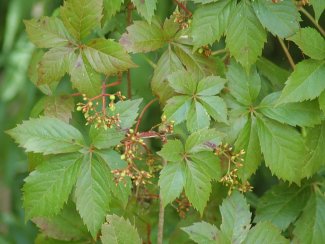Eastern and central North America, from southeastern Canada and the eastern United States west to Manitoba and Utah, and south to eastern Mexico and Guatemala
P. quinquefolia is a prolific deciduous climber, reaching heights of 20–30 m (66–98 ft) in the wild. It climbs smooth surfaces using small forked tendrils tipped with small strongly adhesive pads 5 mm (0.20 in) in size
The flowers are small and greenish, produced in inconspicuous clusters in late spring, and mature in late summer or early fall into small hard purplish-black berries 5 to 7 mm (0.20 to 0.28 in) diameter
P. quinquefolia is grown as an ornamental plant, because of its ability to rapidly cover walls and buildings, and its deep red to burgundy fall (autumn) foliage.[11]
It is frequently seen covering telephone poles or trees. It may kill other plants it covers by shading its support and thus limiting the supporting plants' ability to photosynthesize.
P. quinquefolia can be used as a shading vine for buildings on masonry walls. Because the vine, like its relative P. tricuspidata (Boston ivy), adheres to the surface by disks rather than penetrating roots, it does not harm the masonry but will keep a building cooler by shading the wall surface during the summer. As with ivy, ripping the plant from the wall will leave the adhesive disks behind. If the plant clings to fragile surfaces it can first be killed by severing the vine from the root. The adhesive pads will then eventually deteriorate and release their grip (Wikipedia).
